Unit 4 Don't eat in class.复习知识点课件(共26张PPT)
文档属性
| 名称 | Unit 4 Don't eat in class.复习知识点课件(共26张PPT) | 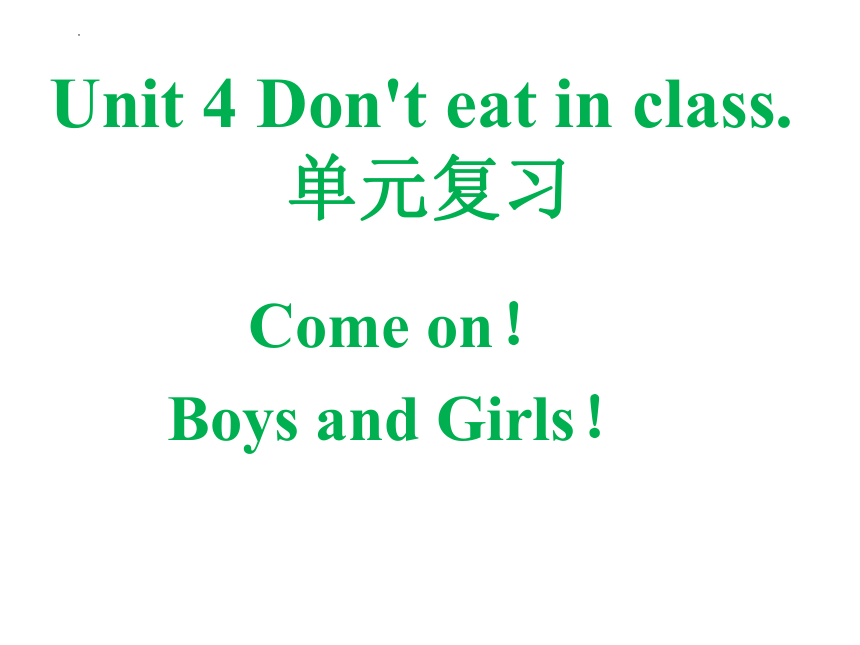 | |
| 格式 | pptx | ||
| 文件大小 | 185.9KB | ||
| 资源类型 | 教案 | ||
| 版本资源 | 人教新目标(Go for it)版 | ||
| 科目 | 英语 | ||
| 更新时间 | 2022-08-09 12:10:43 | ||
图片预览

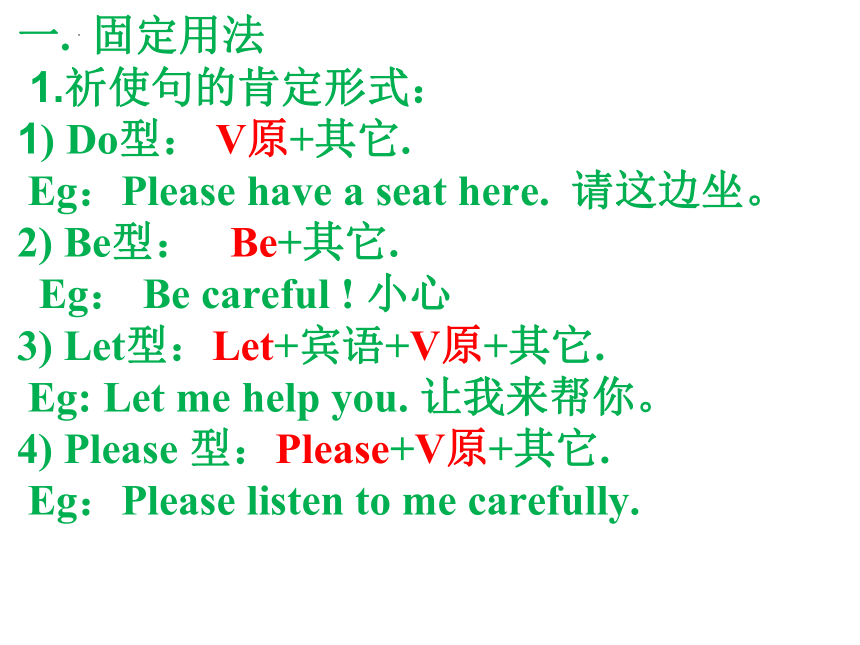
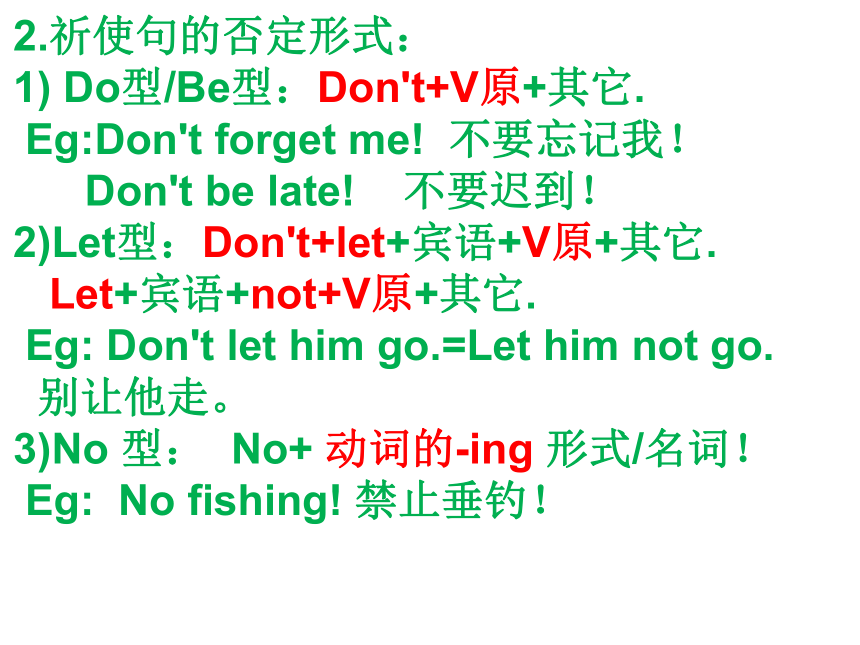
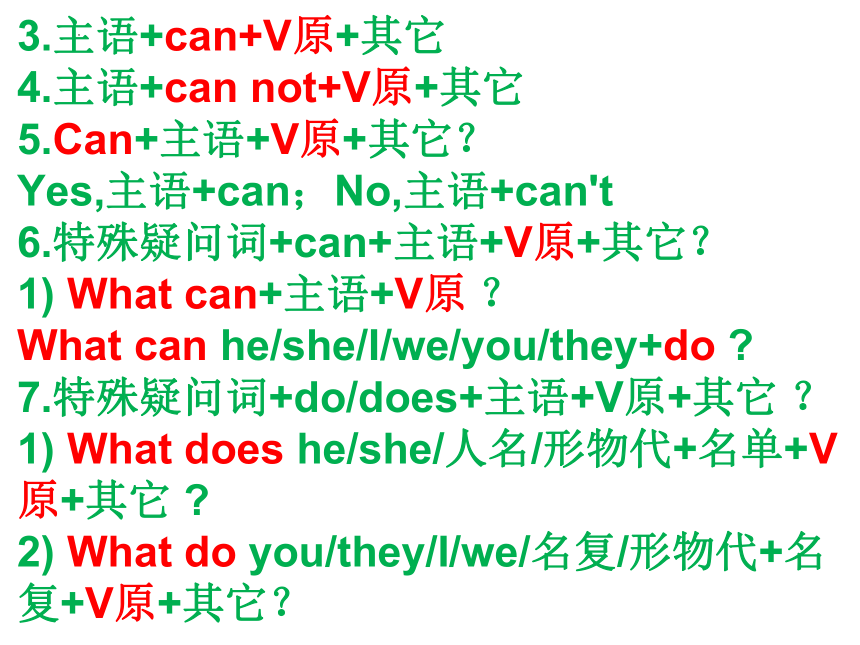
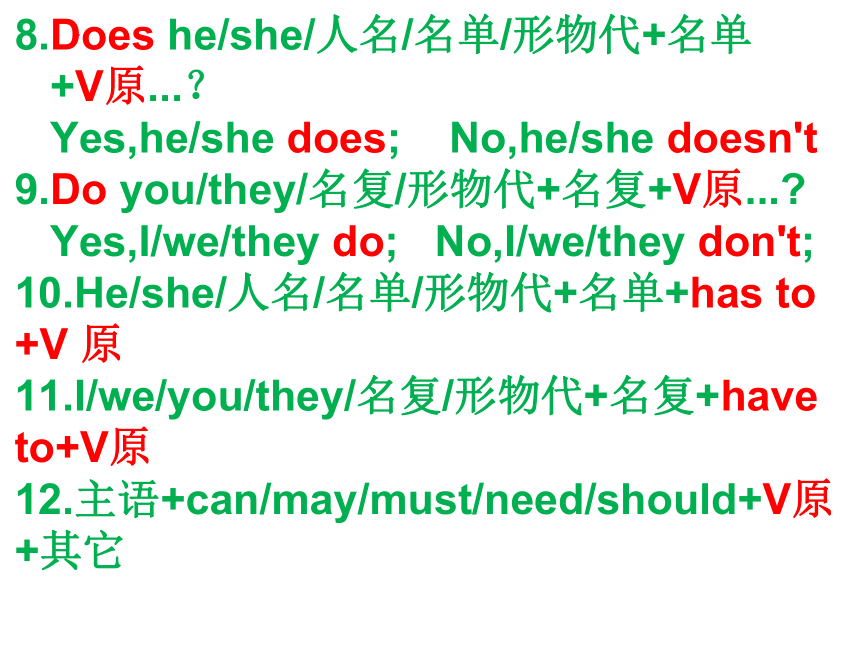
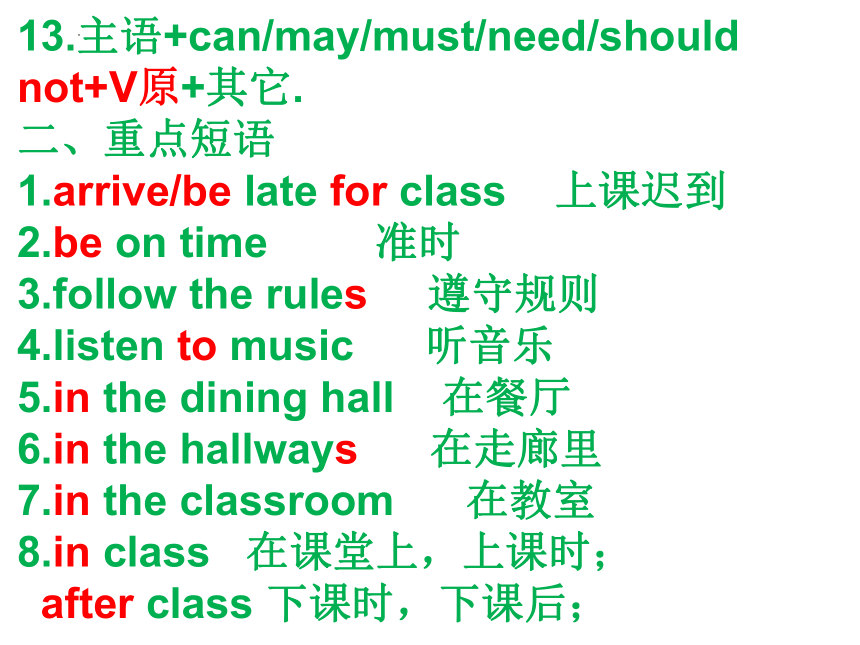
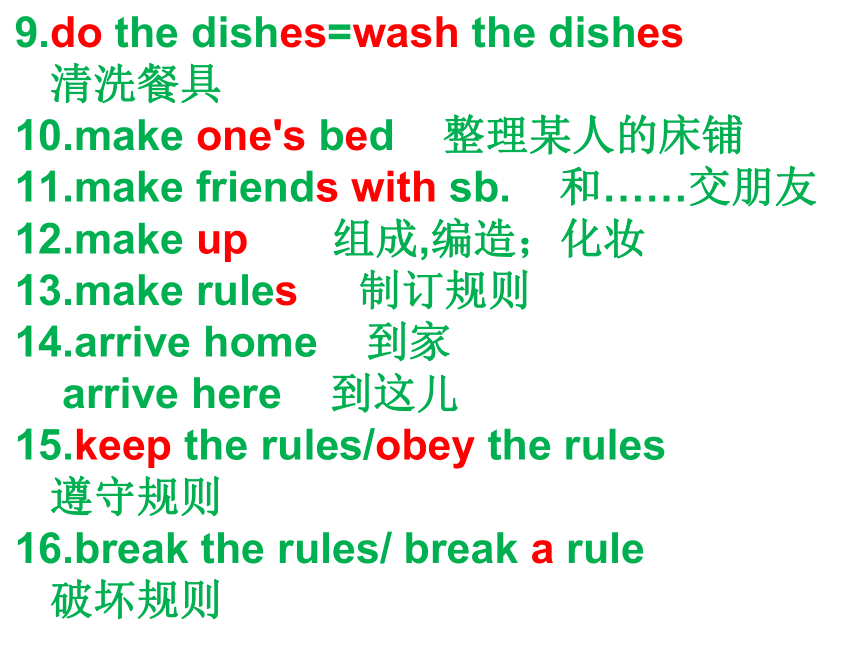
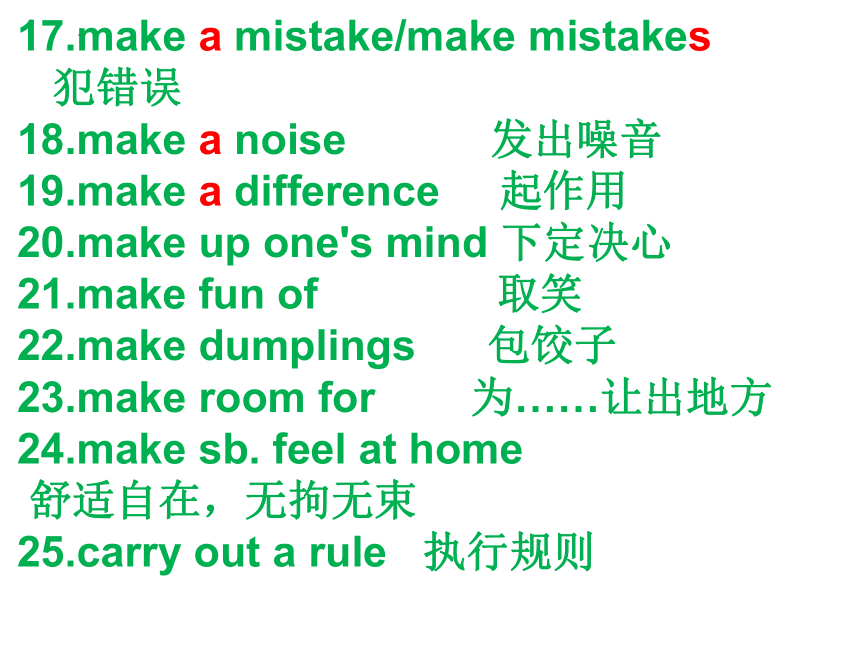
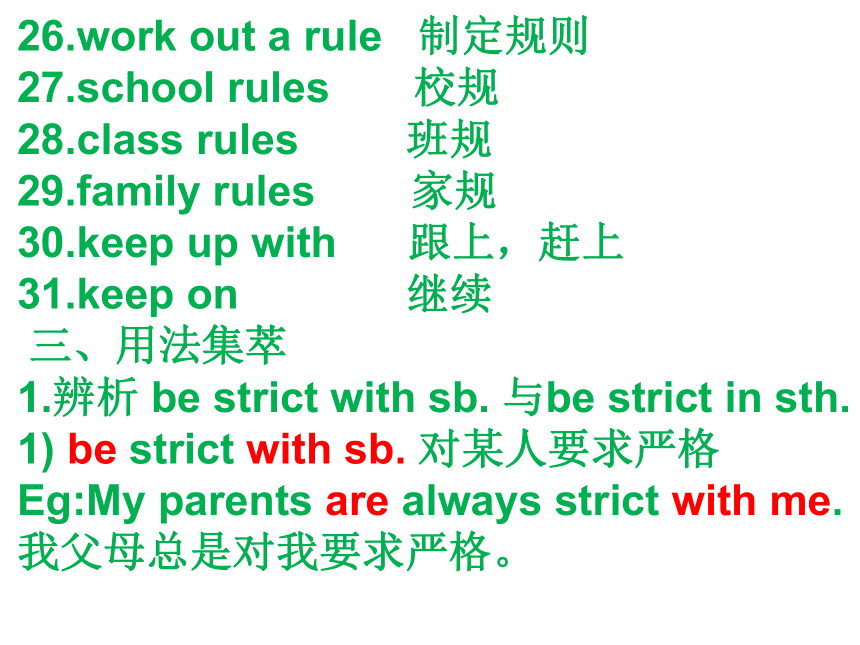
文档简介
(共25张PPT)
Unit 4 Don't eat in class.
单元复习
Come on!
Boys and Girls!
一. 固定用法
1.祈使句的肯定形式:
1) Do型: V原+其它.
Eg:Please have a seat here. 请这边坐。
2) Be型: Be+其它.
Eg: Be careful ! 小心
3) Let型:Let+宾语+V原+其它.
Eg: Let me help you. 让我来帮你。
4) Please 型:Please+V原+其它.
Eg:Please listen to me carefully.
2.祈使句的否定形式:
1) Do型/Be型:Don't+V原+其它.
Eg:Don't forget me! 不要忘记我!
Don't be late! 不要迟到!
2)Let型:Don't+let+宾语+V原+其它.
Let+宾语+not+V原+其它.
Eg: Don't let him go.=Let him not go.
别让他走。
3)No 型: No+ 动词的-ing 形式/名词!
Eg: No fishing! 禁止垂钓!
3.主语+can+V原+其它
4.主语+can not+V原+其它
5.Can+主语+V原+其它?
Yes,主语+can;No,主语+can't
6.特殊疑问词+can+主语+V原+其它?
1) What can+主语+V原 ?
What can he/she/I/we/you/they+do
7.特殊疑问词+do/does+主语+V原+其它 ?
1) What does he/she/人名/形物代+名单+V原+其它
2) What do you/they/I/we/名复/形物代+名复+V原+其它?
8.Does he/she/人名/名单/形物代+名单
+V原...?
Yes,he/she does; No,he/she doesn't
9.Do you/they/名复/形物代+名复+V原...
Yes,I/we/they do; No,I/we/they don't;
10.He/she/人名/名单/形物代+名单+has to +V 原
11.I/we/you/they/名复/形物代+名复+have to+V原
12.主语+can/may/must/need/should+V原+其它
13.主语+can/may/must/need/should not+V原+其它.
二、重点短语
1.arrive/be late for class 上课迟到
2.be on time 准时
3.follow the rules 遵守规则
4.listen to music 听音乐
5.in the dining hall 在餐厅
6.in the hallways 在走廊里
7.in the classroom 在教室
8.in class 在课堂上,上课时;
after class 下课时,下课后;
9.do the dishes=wash the dishes
清洗餐具
10.make one's bed 整理某人的床铺
11.make friends with sb. 和……交朋友
12.make up 组成,编造;化妆
13.make rules 制订规则
14.arrive home 到家
arrive here 到这儿
15.keep the rules/obey the rules
遵守规则
16.break the rules/ break a rule
破坏规则
17.make a mistake/make mistakes
犯错误
18.make a noise 发出噪音
19.make a difference 起作用
20.make up one's mind 下定决心
21.make fun of 取笑
22.make dumplings 包饺子
23.make room for 为……让出地方
24.make sb. feel at home
舒适自在,无拘无束
25.carry out a rule 执行规则
26.work out a rule 制定规则
27.school rules 校规
28.class rules 班规
29.family rules 家规
30.keep up with 跟上,赶上
31.keep on 继续
三、用法集萃
1.辨析 be strict with sb. 与be strict in sth.
1) be strict with sb. 对某人要求严格
Eg:My parents are always strict with me.
我父母总是对我要求严格。
2)be strict in sth. 对某事要求严格
Eg: Our teacher is strict in his work.
我们的老师对他的工作要求很严格。
2.fight for 为...而战斗,后接动词ing形式、名词、代词(宾格),表示战斗的目的;
Eg:They fight for their country.
他为他们的祖国而战。
3.fight with sb. 和...打架,战斗;
Eg:I'll fight with you. 我将和你一起战斗。
4.fight against (sb.) 抵抗,对抗;
5.辨析remember to do sth.与 remember doing sth.
1)remember to do sth.
记得要去做某事,说明事情还没有做
forget to do sth.
忘记要去做某事,说明事情还没有做
2)remember doing sth.
记得做过某事,说明事情已经做过
forget doing sth.
忘记做过某事,说明事情已经做过
6.1)too many+可数名词复数;
Eg:I have too many books.
2)too much+不可数名词;
Eg:I have too much work to do. 我有太多的工作去做。
3)much too +形容词/副词;
Eg:He is much too tall. 他太高了。
7.practice +V-ing/名词/代词
拓展:后跟动词ing的形式有:finish、be busy、be worth(值得)、keep on(继续)、be used to(习惯于)、
give up(放弃)、consider(考虑,认为)
enjoy、mind(介意)、miss(思念)、can’t help (禁不住)、feel like(喜欢)look forward to(盼望,期望)、
risk(冒险)put off (推辞)、
can't stand (不能容忍)
8.on time 准时(在规定的时间之内)
in time 及时(恰在时间点上)
9.listen 不及物动词,后接宾语时,需要加介词to;侧重听的动作;
hear 及物动词,强调听的结果;
10.have to 与must的区别
1)have to 表示客观需要做的事情,意思是“必须; 不得不”,有人称和数的变化,其第三人称单数形式为has to,后跟动词原形;have to 强调客观存在的必要性,含有不情愿的色彩,不能用来表示推测。含有have/has to 的句子要借助于助动词do/does 以及don’t/doesn’t 构成一般疑问句或否定句,其结构为:
1)He/She/ 人名/形物代+名单+ has to+V原
2)I/we/you/they/形物代+名复+ have to
+V原
3)I/we/you/they/形物代+名复+don't have
to+V原;
4)He/She/ 人名/形物代+名单+doesn't
have to+V原;
2)must 为情态动词,意为“必须,一定”,后接动词原形,以must 开头的一般疑问句,若作否定回答,可以用needn't 或don't have to,不用mustn’t;must 表示说话人的主观意志和看法,含有自觉、自愿的色彩。
11.辨析:wear, put on, dress, have… on与in
1)wear 强调“穿;戴”的状态,其宾语可以是衣服、鞋帽、首饰或眼镜等。
2)put on 侧重“穿;戴”的动作,可用于穿衣服、穿鞋、戴帽等。
Eg: Please put on your coat.
请穿上你的外套。
3)dress 意为“穿衣服;给(某人)穿衣服”,表“穿”的动作时,宾语是人,不是衣服。
Eg:She dresses her little brother every morning.
她每天早上给她弟弟穿衣服。
4)have on 表示状态,和wear相似,也可以表示“随身携带……”
Eg:The emperor had nothing on. 皇帝什么也没穿。
4)in 表示“穿;戴”的状态;后接表示衣服颜色的词。
Eg:The boy in blue is my brother.
穿蓝色衣服的那个男孩是我弟弟。
11.It is important for sb. to do sth.
意为:做某事对某人来说是重要的,其结构形式为:It is +adj.+for sb. +to do sth.
13.important的名词形式为importance, 是不可数名词。
The importance of... ...的重要性
14.辨析:bring 与take
1)bring 意为“带来;拿来”,指从别处带到说话者所在的地方来;
bring sth./sb. to sp. 意为“把某物/ 某人带来某地”
2)take 意为“带走;拿走”,指从说话者所在的地方带到远处去。常与介词to连用,方向上与bring正好相反;
take sb. to sp. 把某人带到某地;
15.辨析in class和in the class
1)in class 在课上;上课时;
2)in the class 在这个班
3)at table 吃饭 at the table 在桌子旁
16.辨析forget和leave
1)forget “遗忘;记不起”,指忘记某事/某物,不与地点状语连用。
Eg:I forget his phone number.
我忘记了他的电话号码。
2)leave “忘了带,丢下;留在”,常与地点状语连用,表示把某物落在/留在某地。
Eg:I left my homework at home.
我把我的家庭作业落在家里了。
17.辨析read, watch, see与look
1)read 意为“阅读”,侧重指看文字性的东西,可用于read sth. to sb.或read sb. sth.结构。
Eg:He is reading a book. 他正在看书。
2)watch 意为“观看;注视”,指非常仔细地、有目的地、全神贯注地“看”,多指观看运动着的事物,如:看电视、比赛、表演等。
3)see 意为“看见;看到”,强调看的结果,指有意或无意地看到,无进行时态。
Eg:I saw him leave a few minutes ago.几分钟前我看见他离开了。
4)look 意为“看”,强调看的动作,表示有意识地集中精力去看。后跟宾语时用look at。
Eg:I looked but saw nothing.
我看了,但什么也没看到。
18.luck 用作不可数名词,意为“幸运;运气”。
1)good luck (to sb.) 表示“祝( 某人) 好运”,
2)bad luck 意为“倒霉”。
lucky adj. 幸运的 luckily adv. 幸运地
unlucky adj. 不幸的 unluckily adv. 不幸地
19.have fun 玩得高兴;获得乐趣;fun是不可数名词,其前可用no,much,a lot of 等词修饰。
1)have fun+doing=have a good/great time +doing=enjoy oneself
玩得高兴;过得愉快;
20.1)learn to do sth. 学会做某事;
Eg:He is learning to dance.
2)learn from 向...学习
Eg:We should learn from Lei Feng.
3)learn about 学习关于...
Eg:He wants to learn about the history of China.
4)learn by oneself 自学
Eg:The boy learns English by himself.
这个男孩自学英语。
21.keep +宾语+形容词;
Eg:we must keep the classroom clean.
22.before的用法
1)before用作介词,表示时间,意为“在...以前”,其后跟动词ing;反义词after;表示位置,意为“在...前面”,反义词behind;
2)作为连词,其后跟句子
23.keep sb.doing sth. 让某人一直做某事
Unit 4 Don't eat in class.
单元复习
Come on!
Boys and Girls!
一. 固定用法
1.祈使句的肯定形式:
1) Do型: V原+其它.
Eg:Please have a seat here. 请这边坐。
2) Be型: Be+其它.
Eg: Be careful ! 小心
3) Let型:Let+宾语+V原+其它.
Eg: Let me help you. 让我来帮你。
4) Please 型:Please+V原+其它.
Eg:Please listen to me carefully.
2.祈使句的否定形式:
1) Do型/Be型:Don't+V原+其它.
Eg:Don't forget me! 不要忘记我!
Don't be late! 不要迟到!
2)Let型:Don't+let+宾语+V原+其它.
Let+宾语+not+V原+其它.
Eg: Don't let him go.=Let him not go.
别让他走。
3)No 型: No+ 动词的-ing 形式/名词!
Eg: No fishing! 禁止垂钓!
3.主语+can+V原+其它
4.主语+can not+V原+其它
5.Can+主语+V原+其它?
Yes,主语+can;No,主语+can't
6.特殊疑问词+can+主语+V原+其它?
1) What can+主语+V原 ?
What can he/she/I/we/you/they+do
7.特殊疑问词+do/does+主语+V原+其它 ?
1) What does he/she/人名/形物代+名单+V原+其它
2) What do you/they/I/we/名复/形物代+名复+V原+其它?
8.Does he/she/人名/名单/形物代+名单
+V原...?
Yes,he/she does; No,he/she doesn't
9.Do you/they/名复/形物代+名复+V原...
Yes,I/we/they do; No,I/we/they don't;
10.He/she/人名/名单/形物代+名单+has to +V 原
11.I/we/you/they/名复/形物代+名复+have to+V原
12.主语+can/may/must/need/should+V原+其它
13.主语+can/may/must/need/should not+V原+其它.
二、重点短语
1.arrive/be late for class 上课迟到
2.be on time 准时
3.follow the rules 遵守规则
4.listen to music 听音乐
5.in the dining hall 在餐厅
6.in the hallways 在走廊里
7.in the classroom 在教室
8.in class 在课堂上,上课时;
after class 下课时,下课后;
9.do the dishes=wash the dishes
清洗餐具
10.make one's bed 整理某人的床铺
11.make friends with sb. 和……交朋友
12.make up 组成,编造;化妆
13.make rules 制订规则
14.arrive home 到家
arrive here 到这儿
15.keep the rules/obey the rules
遵守规则
16.break the rules/ break a rule
破坏规则
17.make a mistake/make mistakes
犯错误
18.make a noise 发出噪音
19.make a difference 起作用
20.make up one's mind 下定决心
21.make fun of 取笑
22.make dumplings 包饺子
23.make room for 为……让出地方
24.make sb. feel at home
舒适自在,无拘无束
25.carry out a rule 执行规则
26.work out a rule 制定规则
27.school rules 校规
28.class rules 班规
29.family rules 家规
30.keep up with 跟上,赶上
31.keep on 继续
三、用法集萃
1.辨析 be strict with sb. 与be strict in sth.
1) be strict with sb. 对某人要求严格
Eg:My parents are always strict with me.
我父母总是对我要求严格。
2)be strict in sth. 对某事要求严格
Eg: Our teacher is strict in his work.
我们的老师对他的工作要求很严格。
2.fight for 为...而战斗,后接动词ing形式、名词、代词(宾格),表示战斗的目的;
Eg:They fight for their country.
他为他们的祖国而战。
3.fight with sb. 和...打架,战斗;
Eg:I'll fight with you. 我将和你一起战斗。
4.fight against (sb.) 抵抗,对抗;
5.辨析remember to do sth.与 remember doing sth.
1)remember to do sth.
记得要去做某事,说明事情还没有做
forget to do sth.
忘记要去做某事,说明事情还没有做
2)remember doing sth.
记得做过某事,说明事情已经做过
forget doing sth.
忘记做过某事,说明事情已经做过
6.1)too many+可数名词复数;
Eg:I have too many books.
2)too much+不可数名词;
Eg:I have too much work to do. 我有太多的工作去做。
3)much too +形容词/副词;
Eg:He is much too tall. 他太高了。
7.practice +V-ing/名词/代词
拓展:后跟动词ing的形式有:finish、be busy、be worth(值得)、keep on(继续)、be used to(习惯于)、
give up(放弃)、consider(考虑,认为)
enjoy、mind(介意)、miss(思念)、can’t help (禁不住)、feel like(喜欢)look forward to(盼望,期望)、
risk(冒险)put off (推辞)、
can't stand (不能容忍)
8.on time 准时(在规定的时间之内)
in time 及时(恰在时间点上)
9.listen 不及物动词,后接宾语时,需要加介词to;侧重听的动作;
hear 及物动词,强调听的结果;
10.have to 与must的区别
1)have to 表示客观需要做的事情,意思是“必须; 不得不”,有人称和数的变化,其第三人称单数形式为has to,后跟动词原形;have to 强调客观存在的必要性,含有不情愿的色彩,不能用来表示推测。含有have/has to 的句子要借助于助动词do/does 以及don’t/doesn’t 构成一般疑问句或否定句,其结构为:
1)He/She/ 人名/形物代+名单+ has to+V原
2)I/we/you/they/形物代+名复+ have to
+V原
3)I/we/you/they/形物代+名复+don't have
to+V原;
4)He/She/ 人名/形物代+名单+doesn't
have to+V原;
2)must 为情态动词,意为“必须,一定”,后接动词原形,以must 开头的一般疑问句,若作否定回答,可以用needn't 或don't have to,不用mustn’t;must 表示说话人的主观意志和看法,含有自觉、自愿的色彩。
11.辨析:wear, put on, dress, have… on与in
1)wear 强调“穿;戴”的状态,其宾语可以是衣服、鞋帽、首饰或眼镜等。
2)put on 侧重“穿;戴”的动作,可用于穿衣服、穿鞋、戴帽等。
Eg: Please put on your coat.
请穿上你的外套。
3)dress 意为“穿衣服;给(某人)穿衣服”,表“穿”的动作时,宾语是人,不是衣服。
Eg:She dresses her little brother every morning.
她每天早上给她弟弟穿衣服。
4)have on 表示状态,和wear相似,也可以表示“随身携带……”
Eg:The emperor had nothing on. 皇帝什么也没穿。
4)in 表示“穿;戴”的状态;后接表示衣服颜色的词。
Eg:The boy in blue is my brother.
穿蓝色衣服的那个男孩是我弟弟。
11.It is important for sb. to do sth.
意为:做某事对某人来说是重要的,其结构形式为:It is +adj.+for sb. +to do sth.
13.important的名词形式为importance, 是不可数名词。
The importance of... ...的重要性
14.辨析:bring 与take
1)bring 意为“带来;拿来”,指从别处带到说话者所在的地方来;
bring sth./sb. to sp. 意为“把某物/ 某人带来某地”
2)take 意为“带走;拿走”,指从说话者所在的地方带到远处去。常与介词to连用,方向上与bring正好相反;
take sb. to sp. 把某人带到某地;
15.辨析in class和in the class
1)in class 在课上;上课时;
2)in the class 在这个班
3)at table 吃饭 at the table 在桌子旁
16.辨析forget和leave
1)forget “遗忘;记不起”,指忘记某事/某物,不与地点状语连用。
Eg:I forget his phone number.
我忘记了他的电话号码。
2)leave “忘了带,丢下;留在”,常与地点状语连用,表示把某物落在/留在某地。
Eg:I left my homework at home.
我把我的家庭作业落在家里了。
17.辨析read, watch, see与look
1)read 意为“阅读”,侧重指看文字性的东西,可用于read sth. to sb.或read sb. sth.结构。
Eg:He is reading a book. 他正在看书。
2)watch 意为“观看;注视”,指非常仔细地、有目的地、全神贯注地“看”,多指观看运动着的事物,如:看电视、比赛、表演等。
3)see 意为“看见;看到”,强调看的结果,指有意或无意地看到,无进行时态。
Eg:I saw him leave a few minutes ago.几分钟前我看见他离开了。
4)look 意为“看”,强调看的动作,表示有意识地集中精力去看。后跟宾语时用look at。
Eg:I looked but saw nothing.
我看了,但什么也没看到。
18.luck 用作不可数名词,意为“幸运;运气”。
1)good luck (to sb.) 表示“祝( 某人) 好运”,
2)bad luck 意为“倒霉”。
lucky adj. 幸运的 luckily adv. 幸运地
unlucky adj. 不幸的 unluckily adv. 不幸地
19.have fun 玩得高兴;获得乐趣;fun是不可数名词,其前可用no,much,a lot of 等词修饰。
1)have fun+doing=have a good/great time +doing=enjoy oneself
玩得高兴;过得愉快;
20.1)learn to do sth. 学会做某事;
Eg:He is learning to dance.
2)learn from 向...学习
Eg:We should learn from Lei Feng.
3)learn about 学习关于...
Eg:He wants to learn about the history of China.
4)learn by oneself 自学
Eg:The boy learns English by himself.
这个男孩自学英语。
21.keep +宾语+形容词;
Eg:we must keep the classroom clean.
22.before的用法
1)before用作介词,表示时间,意为“在...以前”,其后跟动词ing;反义词after;表示位置,意为“在...前面”,反义词behind;
2)作为连词,其后跟句子
23.keep sb.doing sth. 让某人一直做某事
同课章节目录
- Unit 1 Can you play the guitar?
- Section A
- Section B
- Unit 2 What time do you go to school?
- Section A
- Section B
- Unit 3 How do you get to school?
- Section A
- Section B
- Unit 4 Don't eat in class.
- Section A
- Section B
- Unit 5 Why do you like pandas?
- Section A
- Section B
- Unit 6 I'm watching TV.
- Section A
- Section B
- Review of Units 1-6
- Unit 7 It's raining!
- Section A
- Section B
- Unit 8 Is there a post office near here?
- Section A
- Section B
- Unit 9 What does he look like?
- Section A
- Section B
- Unit 10 I'd like some noodles.
- Section A
- Section B
- Unit 11 How was your school trip?
- Section A
- Section B
- Unit 12 What did you do last weekend?
- Section A
- Section B
